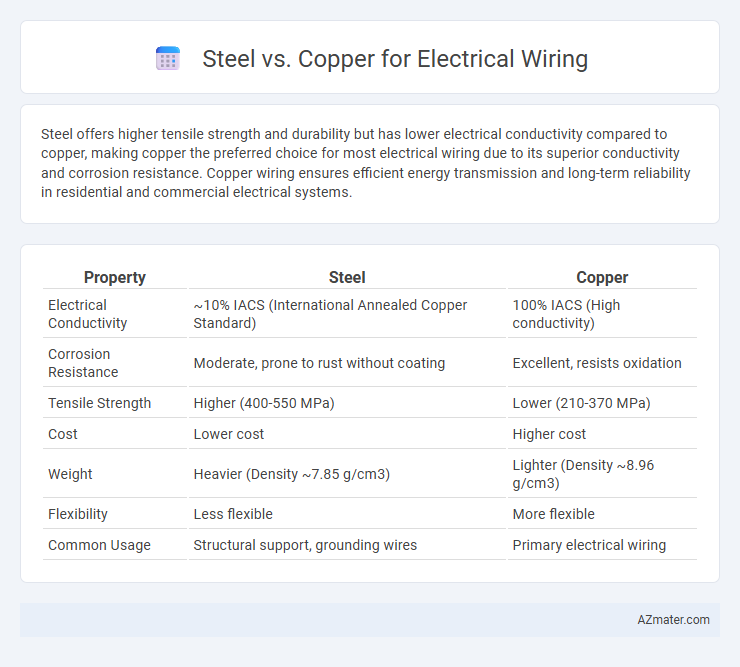Steel offers higher tensile strength and durability but has lower electrical conductivity compared to copper, making copper the preferred choice for most electrical wiring due to its superior conductivity and corrosion resistance. Copper wiring ensures efficient energy transmission and long-term reliability in residential and commercial electrical systems.
Table of Comparison
| Property | Steel | Copper |
|---|---|---|
| Electrical Conductivity | ~10% IACS (International Annealed Copper Standard) | 100% IACS (High conductivity) |
| Corrosion Resistance | Moderate, prone to rust without coating | Excellent, resists oxidation |
| Tensile Strength | Higher (400-550 MPa) | Lower (210-370 MPa) |
| Cost | Lower cost | Higher cost |
| Weight | Heavier (Density ~7.85 g/cm3) | Lighter (Density ~8.96 g/cm3) |
| Flexibility | Less flexible | More flexible |
| Common Usage | Structural support, grounding wires | Primary electrical wiring |
Introduction to Electrical Wiring Materials
Copper offers superior electrical conductivity and corrosion resistance, making it the preferred choice for most residential and commercial electrical wiring applications. Steel, while less conductive, provides greater tensile strength and lower cost, often used in grounding systems or armored cables where durability is essential. Understanding these material properties is crucial when selecting wiring to ensure safety, efficiency, and compliance with electrical codes.
Overview of Steel and Copper Wire Properties
Copper wire boasts superior electrical conductivity, approximately 59.6 x 10^6 S/m, enabling more efficient current flow and reduced energy losses compared to steel wire, which has a conductivity around 10 x 10^6 S/m. Steel wire offers higher tensile strength and durability, making it more resistant to mechanical stress, corrosion, and fatigue, but its increased electrical resistance results in higher heat generation under load. The choice between steel and copper for electrical wiring depends largely on balancing conductivity requirements with mechanical robustness and cost considerations.
Conductivity Comparison: Steel vs Copper
Copper offers significantly higher electrical conductivity than steel, with copper's conductivity approximately 59.6 million siemens per meter (S/m) compared to steel's much lower range around 1.45 to 10 million S/m depending on alloy composition. This substantial difference makes copper the preferred choice for electrical wiring, ensuring reduced energy loss and improved efficiency. Steel's lower conductivity results in greater resistance and heat generation, limiting its use to specialized applications where strength and durability outweigh conductivity concerns.
Durability and Lifespan Differences
Copper wiring offers superior durability and a longer lifespan due to its excellent corrosion resistance and high conductivity, reducing the risk of overheating and electrical failures. Steel wiring, while stronger and more resistant to physical damage, tends to corrode more easily and has a shorter lifespan, especially in moist environments. Choosing copper for electrical wiring ensures enhanced reliability and reduced maintenance over time compared to steel.
Installation and Flexibility Considerations
Steel wiring is harder and less flexible than copper, making installation in tight spaces or around corners more challenging and time-consuming. Copper's superior ductility allows for easier bending and pulling through conduits, reducing labor costs and installation time. The rigidity of steel may require additional connectors and support, while copper wiring offers smoother handling and better adaptability in complex electrical layouts.
Cost Analysis: Steel vs Copper Wiring
Steel wiring typically costs significantly less per foot than copper, making it a more budget-friendly choice for large-scale electrical installations. Copper offers superior conductivity and durability, which can reduce energy losses and long-term maintenance expenses despite its higher initial price. Evaluating total cost requires balancing the upfront material expense of steel with the efficiency and lifecycle benefits copper wiring provides.
Safety and Fire Resistance Factors
Steel wiring offers superior fire resistance due to its high melting point and low combustibility, reducing the risk of fire hazards compared to copper. Copper wiring, while more conductive and flexible, poses a higher fire risk if damaged or improperly installed because it can overheat and cause sparks. Safety standards often recommend steel wiring in environments prone to fire or mechanical damage to enhance overall electrical safety.
Environmental Impact and Sustainability
Steel wiring, while less conductive than copper, offers a lower environmental impact due to its high recyclability and abundance, reducing the need for intensive mining activities. Copper extraction and processing involve significant energy consumption and habitat disruption, contributing to higher carbon emissions and environmental degradation. Choosing steel over copper in electrical wiring supports sustainability goals by minimizing resource depletion and promoting circular economy practices through efficient recycling.
Common Applications in Residential and Industrial Wiring
Copper is the preferred choice for residential electrical wiring due to its superior conductivity, corrosion resistance, and flexibility, which ensures safety and efficiency in household circuits, outlets, and lighting systems. Steel, commonly used in industrial wiring, is favored for its strength and durability, often employed in armored cables and grounding applications where mechanical protection is critical. While copper wiring dominates in residential settings for standard circuit wiring, steel is integral in environments requiring robust, long-lasting conduit and structural support.
Choosing the Right Material for Your Wiring Needs
Steel wiring offers high tensile strength and cost efficiency but has higher electrical resistance and is less conductive than copper. Copper provides superior conductivity, corrosion resistance, and flexibility, making it ideal for most residential and commercial electrical applications. Selecting the right material depends on factors such as budget, electrical load requirements, environmental conditions, and long-term durability considerations.

Infographic: Steel vs Copper for Electrical Wiring
 azmater.com
azmater.com